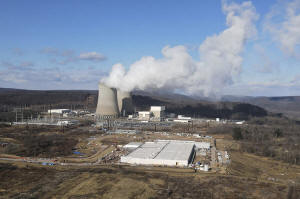Big Tech wants to plug data centers right into power plants. Utilities
say it's not fair
 Send a link to a friend
Send a link to a friend
 [January 27, 2025] By
MARC LEVY [January 27, 2025] By
MARC LEVY
HARRISBURG, Pa. (AP) — Looking for a quick fix for their fast-growing
electricity diets, tech giants are increasingly looking to strike deals
with power plant owners to plug in directly, avoiding a potentially
longer and more expensive process of hooking into a fraying electric
grid that serves everyone else.
It's raising questions over whether diverting power to higher-paying
customers will leave enough for others and whether it's fair to excuse
big power users from paying for the grid. Federal regulators are trying
to figure out what to do about it, and quickly.
Front and center is the data center that Amazon’s cloud computing
subsidiary, Amazon Web Services, is building next to the Susquehanna
nuclear plant in eastern Pennsylvania.
The arrangement between the plant's owners and AWS — called a “behind
the meter” connection — is the first such to come before the Federal
Energy Regulatory Commission. For now, FERC has rejected a deal that
could eventually send 960 megawatts — about 40% of the plant's capacity
— to the data center. That's enough to power more than a half-million
homes.
That leaves the deal and others that likely would follow in limbo. It's
not clear when FERC, which blocked the deal on a procedural ground, will
take up the matter again or how the change in presidential
administrations might affect things.
“The companies, they’re very frustrated because they have a business
opportunity now that’s really big,” said Bill Green, the director of the
MIT Energy Initiative. “And if they’re delayed five years in the queue,
for example — I don’t know if it would be five years, but years anyway —
they might completely miss the business opportunity.”

What's driving demand for energy-hungry data centers
The rapid growth of cloud computing and artificial intelligence has
fueled demand for data centers that need power to run servers, storage
systems, networking equipment and cooling systems.
That's spurred proposals to bring nuclear power plants out of
retirement, develop small modular nuclear reactors and build
utility-scale renewable installations or new natural gas plants. In
December, California-based Oklo announced an agreement to provide 12
gigawatts to data center developer Switch from small nuclear reactors
powered by nuclear waste.
Federal officials say fast development of data centers is vital to the
economy and national security, including to keep pace with China in the
artificial intelligence race.
For AWS, the deal with Susquehanna satisfies its need for reliable power
that meets its internal requirements for sources that don't emit
planet-warming greenhouse gases, like coal, oil or gas-fueled plants.
Big Tech also wants to stand up their centers fast. But tech's voracious
appetite for energy comes at a time when the power supply is already
strained by efforts to shift away from planet-warming fossil fuels.
They can build data centers in a couple years, said Aaron Tinjum of the
Data Center Coalition. But in some areas, getting connected to the
congested electricity grid can take four years, and sometimes much more,
he said.
Plugging directly into a power plant would take years off their
development timelines.
What's in it for power providers
In theory, the AWS deal would let Susquehanna sell power for more than
they get by selling into the grid. Talen Energy, Susquehanna’s majority
owner, projected the deal would bring as much as $140 million in
electricity sales in 2028, though it didn't disclose exactly how much
AWS will pay for the power.
[to top of second column] |

A data center owned by Amazon Web Services, front right, is under
construction next to the Susquehanna nuclear power plant in Berwick,
Pa., on Tuesday, Jan. 14, 2024. (AP Photo/Ted Shaffrey)
 The profit potential is one that
other nuclear plant operators, in particular, are embracing after
years of financial distress and frustration with how they are paid
in the broader electricity markets. Many say they have been forced
to compete in some markets against a flood of cheap natural gas as
well as state-subsidized solar and wind energy.
Power plant owners also say the arrangement benefits the wider
public, by bypassing the costly buildout of long power lines and
leaving more transmission capacity on the grid for everyone else.
FERC's big decision
A favorable ruling from FERC could open the door to many more huge
data centers and other massive power users like hydrogen plants and
bitcoin miners, analysts say.
FERC’s 2-1 rejection in November was procedural. Recent comments by
commissioners suggest they weren't ready to decide how to regulate
such a novel matter without more study.
In the meantime, the agency is hearing arguments for and against the
Susquehanna-AWS deal.
Monitoring Analytics, the market watchdog in the mid-Atlantic grid,
wrote in a filing to FERC that the impact would be “extreme” if the
Susquehanna-AWS model were extended to all nuclear power plants in
the territory.
Energy prices would increase significantly and there's no
explanation for how rising demand for power will be met even before
big power plants drop out of the supply mix, it said.
Separately, two electric utility owners — which make money in
deregulated states from building out the grid and delivering power —
have protested that the Susquehanna-AWS arrangement amounts to
freeloading off a grid that ordinary customers pay to build and
maintain. Chicago-based Exelon and Columbus, Ohio-based American
Electric Power say the Susquehanna-AWS arrangement would allow AWS
to avoid $140 million a year that it would otherwise owe.
Susquehanna’s owners say the data center won't be on the grid and
question why it should have to pay to maintain it. But critics
contend that the power plant itself is benefiting from taxpayer
subsidies and ratepayer-subsidized services, and shouldn't be able
to strike deals with private customers that could increase costs for
others.
FERC's decision will have “massive repercussions for the entire
country” because it will set a precedent for how FERC and grid
operators will handle the waiting avalanche of similar requests from
data center companies and nuclear plants, said Jackson Morris of the
Natural Resources Defense Council.
Stacey Burbure, a vice president for American Electric Power, told
FERC at a hearing in November that it needs to move quickly.
“The timing of this issue is before us," she said, “and if we take
our typical five years to get this perfect, it will be too late.”
All contents © copyright 2025 Associated Press. All rights reserved
 |